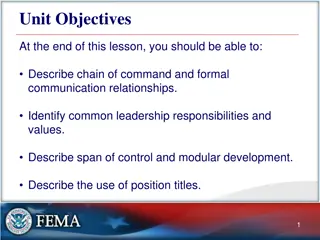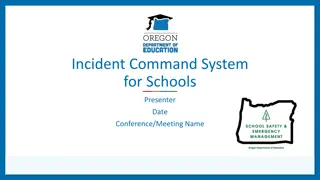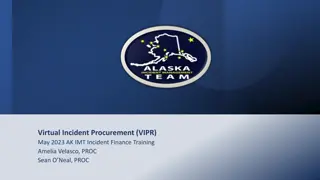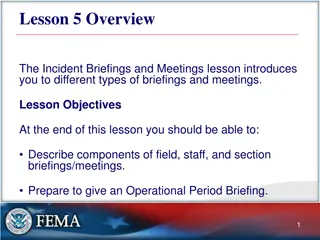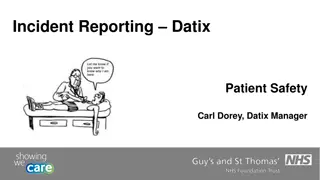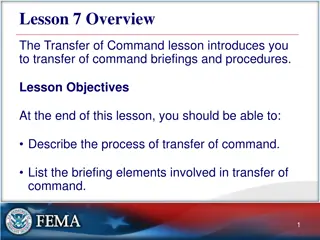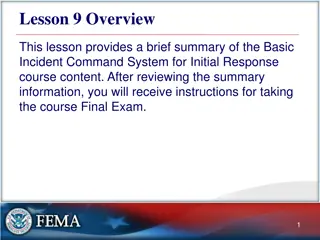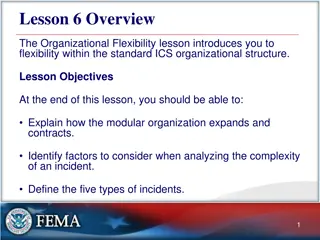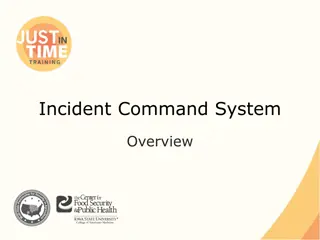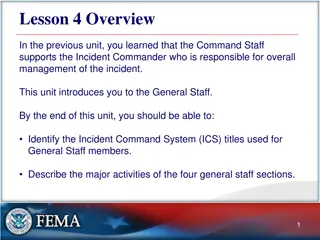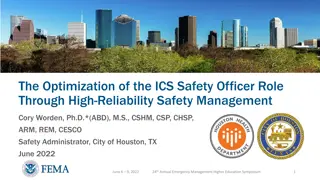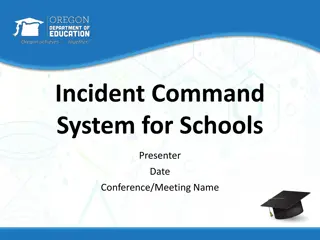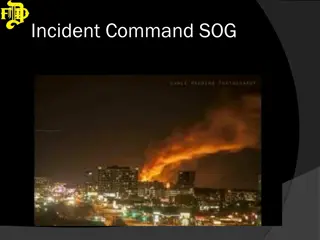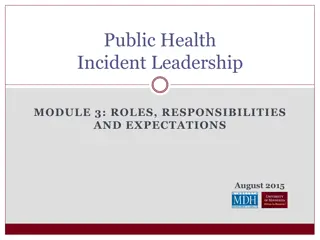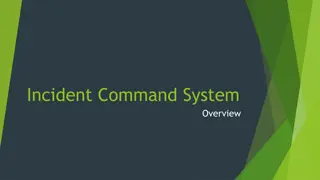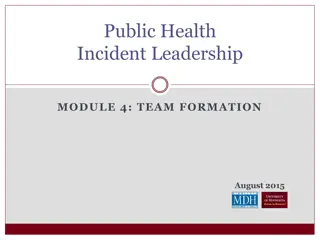Understanding Incident Command System (ICS) Organizational Components
This lesson introduces the key components of the Incident Command System (ICS), including the Command Staff, General Staff, and essential tools. It covers the roles of the Incident Commander, Deputy Incident Commander, and Command Staff positions, emphasizing their functions in managing incidents effectively. Additionally, it discusses the activation of specific staff positions based on the incident's requirements and the importance of designated Deputies for seamless operation.
- Incident Command System
- ICS organizational components
- Command Staff
- General Staff
- Incident Commander
Download Presentation

Please find below an Image/Link to download the presentation.
The content on the website is provided AS IS for your information and personal use only. It may not be sold, licensed, or shared on other websites without obtaining consent from the author. Download presentation by click this link. If you encounter any issues during the download, it is possible that the publisher has removed the file from their server.
E N D
Presentation Transcript
Lesson 4 Overview The Functional Areas and Positions lesson introduces you to ICS organizational components, the Command Staff, the General Staff, and ICS tools. Lesson Objectives At the end of this lesson, you should be able to: Describe the functions of organizational positions within the Incident Command System (ICS). Identify the ICS tools needed to manage an incident. Demonstrate the use of an ICS Form 201. This lesson provides more in-depth information on ICS organizational elements. 1
Incident Commander The Incident Commander: Has overall incident management responsibility delegated by the appropriate jurisdictional authority Develops the incident objectives to guide the Incident Action Planning Process Approves the Incident Action Plan and all requests pertaining to the ordering and releasing of incident resources In some situations or agencies, a lower ranking but more qualified person may be designated as the Incident Commander. Whatever their day-to-day position, when a person is designated as the Incident Commander they are delegated the authority to command the incident response. 2
Incident Commander (Continued) The Incident Commander performs all major ICS functions unless he or she activates Command or General Staff positions to manage these functions. For example, the Incident Commander would personally perform the Operations function until an Operations Section was activated. 3
Deputy Incident Commander The Incident Commander may have one or more Deputies. Deputies may be assigned at the Incident Command, Section, or Branch levels. The only ICS requirement regarding the use of a Deputy is that the Deputy must be fully qualified and equally capable to assume the position. The three primary reasons to designate a Deputy Incident Commander are to: Perform specific tasks as requested by the Incident Commander. Perform the incident command function in a relief capacity (e.g., to take over for the next operational period). In this case, the Deputy will assume the primary role. Represent an Assisting Agency that may share jurisdiction or have jurisdiction in the future. 4
Command Staff The Command Staff is only activated in response to the needs of the incident. If a Command Staff position is not needed it will not be activated. For example, an incident may not require a Liaison Officer if there are not outside agencies or organizations to coordinate with. Command Staff includes the following positions: Public Information Officer Liaison Officer Safety Officer 5
Discussion Question What are the major responsibilities of the Public Information Officer? 6
Discussion Question What are the major responsibilities of the Safety Officer? 7
Discussion Question What are the major responsibilities of the Liaison Officer? 8
Assistants In a large or complex incident, Command Staff members may need one or more Assistants to help manage their workloads. Each Command Staff member is responsible for organizing his or her Assistants for maximum efficiency. Assistants are subordinates of principal Command Staff positions. As the title indicates, Assistants should have a level of technical capability, qualifications, and responsibility subordinate to the primary positions. Assistants may also be assigned to Unit Leaders (e.g., at camps to supervise unit activities). 9
Discussion Question Scenario: On July 18, 2001, a train carrying hazardous chemicals derailed and caught fire in a downtown Baltimore tunnel, causing a near shutdown of the city and burning so hot that firefighters couldn't reach the flames for 8 hours. At one point, all major highways into the city were blocked off, a Baltimore Orioles game at nearby Camden Yards was canceled, and the Inner Harbor was closed to boat traffic. A water- main break near the tunnel added to the chaos, causing the collapse of part of a major thoroughfare and power outages. What is your recommended course of action? 10
Assisting Agency An agency or jurisdiction will often send resources to assist at an incident. In ICS these are called assisting agencies. An assisting agency is defined as an agency or organization providing personnel, services, or other resources to the agency with direct responsibility for incident management. 11
Cooperating Agency A cooperating agency is an agency supplying assistance other than direct operational or support functions or resources to the incident management effort. Don't get confused between an assisting agency and a cooperating agency! An assisting agency has direct responsibility for incident response, whereas a cooperating agency is simply offering assistance. 12
Agency Representative An Agency Representative is an individual assigned to an incident from an assisting or cooperating agency. The Agency Representative is delegated authority to make decisions on matters affecting that agency's participation at the incident. 13
Expanding Incidents An incident may start small and then expand. As the incident grows in scope and the number of resources needed increases, there may be a need to activate Teams, Units, Divisions, Groups, Branches, or Sections to maintain an appropriate span of control. The optimal span of control for incident management is one supervisor to five subordinates; however, effective incident management may require ratios different from this. The 1:5 ratio is just a guideline. The ability to delegate the supervision of resources not only frees up the Incident Commander to perform critical decision- making and evaluation duties, but also clearly defines the lines of communication to everyone involved in the incident. Next, we'll review the major organizational elements that may be activated during an expanding incident. 14
Operations Section The Operations Section: Directs and coordinates all incident tactical operations Is typically one of the first organizations to be assigned to the incident Expands from the bottom up Has the most incident resources May have Staging Areas and special organizations 15
Operations Section Chief The Operations Section Chief: Is responsible to the Incident Commander for the direct management of all incident- related operational activities Establishes tactical objectives for each operational period Has direct involvement in the preparation of the Incident Action Plan The Operations Section Chief may have one or more Deputies assigned. The assignment of Deputies from other agencies may be advantageous in the case of multijurisdictional incidents. 16
Operations Section: Staging Areas Staging Areas are set up at the incident where resources can wait for a tactical assignment. All resources in the Staging Area are assigned and ready for deployment. Out-of-service resources are NOT located at the Staging Area. After a Staging Area has been designated and named, a Staging Area Manager will be assigned. The Staging Area Manager will report to the Operations Section Chief or to the Incident Commander if the Operations Section Chief has not been designated. 17
Staging Areas: Chain of Command The graphic below shows where the Staging Area Manager fits into the Operations Section. 18
Divisions and Groups Divisions are established to divide an incident into physical or geographical areas of operation. Groups are established to divide the incident into functional areas of operation. For example, a Damage Assessment Task Force, reporting to the Infrastructure Group Supervisor, could work across divisions established to manage two distinct areas of the building that have been damaged the west side of the building (West Division) and the north side (North Division). 19
Branches Branches may be used to serve several purposes and may be functional or geographic in nature. Branches are established when the number of divisions or groups exceeds an effective span of control for the Operations Section Chief. 20
Activity 4.1: THE EXPANDING INCIDENT Activity Purpose: To give students practice at maintaining span of control by adjusting the ICS organization structure as an expanding scenario incident unfolds. Time: 30 minutes Instructions: Working with your team . . . 1. Review the scenario. 2. Using an organization chart format, identify the supervisory structures (Divisions, Branches, Groups, Strike Teams, or Task Forces) that you would use to ensure a proper span of control for the resources currently on the scene. 3. For each organizational element, indicate the title of its supervisor. 4. Choose a spokesperson. Be prepared to present your organizational charts to the class in 15 minutes. Scenario: A swim meet is being held at the Main Street pool with 30 team members and 50 observers. During a race, a sudden electrical storm sends a lightning bolt into a flagpole near the pool and the charge arcs to the water. The pool is instantly electrified, sending guards and parents into the pool to rescue the children. The primary objectives are saving lives and ensuring safety. On-Scene Resources: Local Police: 4 Marked Units; State Police: 2 Marked Units; Fire: 2 Engine Companies; Rescue: 1 Company; and EMS: 5 Basic Life Support and 2 Advanced Life Support 21
Air Operations Branch Some incidents may require the use of aviation resources to provide tactical or logistical support. On smaller incidents, aviation resources will be limited in number and will report directly to the Incident Commander or to the Operations Section Chief. On larger incidents, it may be desirable to activate a separate Air Operations Branch to coordinate the use of aviation resources. The Air Operations Branch, will then report directly to the Operations Section Chief. The Air Operations Branch Director can establish two functional groups. The Air Tactical Group coordinates all airborne activity. The Air Support Group provides all incident ground-based support to aviation resources. 22
Planning Section The Planning Section has responsibility for: Maintaining resource status Maintaining and displaying situation status Preparing the Incident Action Plan (IAP) Developing alternative strategies Providing documentation services Preparing the Demobilization Plan Providing a primary location for Technical Specialists assigned to an incident One of the most important functions of the Planning Section is to look beyond the current and next operational period and anticipate potential problems or events. 23
Planning Section Key Personnel The Planning Section will have a Planning Section Chief. The Planning Section Chief may have a Deputy. Technical Specialists: Are advisors with special skills required at the incident Will initially report to the Planning Section, work within that Section, or be reassigned to another part of the organization Can be in any discipline required (e.g., epidemiology, infection control, chemical-biological-nuclear agents, etc.) 24
Logistics Section Early recognition of the need for a Logistics Section can reduce time and money spent on an incident. The Logistics Section is responsible for all support requirements, including: Communications Medical support to incident personnel Food for incident personnel Supplies, facilities, and ground support 26
Logistics Section: Service Branch The Service Branch may be made up of the following units: The Communications Unit is responsible for developing plans for the effective use of incident communications equipment and facilities, installing and testing of communications equipment, supervision of the Incident Communications Center, distribution of communications equipment to incident personnel, and maintenance and repair of communications equipment. The Medical Unit is responsible for the development of the Medical Plan, obtaining medical aid and transportation for injured and ill incident personnel, and preparation of reports and records. The Food Unit is responsible for supplying the food needs for responder personnel for the entire incident, including all remote locations (e.g., Camps, Staging Areas), as well as providing food for personnel unable to leave tactical field assignments. 28
Logistics Section: Support Branch The Support Branch within the Logistics Section may include the following units: The Supply Unit is responsible for ordering personnel, equipment, and supplies; receiving and storing all supplies for the incident; maintaining an inventory of supplies; and servicing nonexpendable supplies and equipment. The Facilities Unit is responsible for setting up, maintaining, and demobilizing all facilities used in support of incident operations. Facilities Unit staff set up the Incident Command Post (ICP), Incident Base, and camps (including trailers or other forms of shelter in and around the incident area), ensure the maintenance of those facilities, and provide law enforcement/security services needed for incident support. The Ground Support Unit is responsible for supporting out- of-service resources; transporting personnel, supplies, food, and equipment; fueling, service, maintenance, and repair of vehicles and other ground support equipment; and implementing the Traffic Plan for the incident. 29
Finance/Administration Section The Finance/Administration Section: Is established when incident management activities require finance and other administrative support services. Handles claims related to property damage, injuries, or fatalities at the incident. Remember that the ICS organizational structure is flexible and scalable to adapt to any situation. Not all incidents will require a separate Finance/Administration Section. If the full Finance/Administration Section is not needed, it would not be activated. When only one specific function is needed (e.g., cost analysis), a Technical Specialist assigned to the Planning Section could provide these services. 30
Intelligence/Investigations Function in ICS Intelligence/Investigations (I/I) is an ICS function identified in NIMS. When I/I is required for specialized types of responses, the IC/UC can place the I/I function in multiple locations within the incident command structure based on factors such as the nature of the incident, the level of I/I activity, and the relationship of I/I to other incident activities. The I/I can be placed in the Planning Section, in the Operations Section, within the Command Staff, as a separate General Staff section, or in some combination of these locations. 32
Discussion Question When might the I/I function can be established as a branch under Operations? As a fifth General Staff Section within the ICS structure? As a part of the Command Staff? 33
ICS Tools Some important tools you should have available at the incident include: Emergency Operations Plan (EOP) from the affected jurisdiction(s) Agency policies and procedures manuals for responding agencies Maps of the affected area 34
ICS Forms ICS Forms provide a method of recording and communicating key incident-specific information in a format that is simple, consistent, and supports interoperability. When using each ICS Form, you should ensure that you understand the following about each form: Purpose What function does the form perform? Preparation Who is responsible for preparing the form? Distribution Who needs to receive this information? 35
ICS Form 201, Incident Briefing The Incident Briefing Form (ICS Form 201) is an eight-part form that provides an Incident Command/Unified Command with status information that can be used for briefing incoming resources, an incoming Incident Commander or team, or an immediate supervisor. The basic information includes: Incident situation (map, significant events) Incident objectives Summary of current actions Status of resources assigned or ordered for the incident or event 36
ICS Form 201, Incident Briefing (Continued) Occasionally, the ICS Form 201 serves as the initial Incident Action Plan (IAP) until a Planning Section has been established and generates, at the direction of the Incident Commander, an IAP. The ICS Form 201 is also suitable for briefing individuals newly assigned to the Command and General Staffs. 37
ACTIVITY 4.2: USING ICS FORM 201 Activity Purpose: To give students practice completing ICS Form 201 using information from a scenario incident. Time: 60 minutes Instructions: Working in your team: 1. Read the scenario on the following page of your Student Manual. 2. Complete the missing elements in the ICS Form 201, Incident Briefing, for the Emerald City Floods incident provided in your Student Manual, including: Section 4 Sketch: Identify and locate the incident facilities on the sketch provided. Section 5 Current Organization: Create an organizational chart for this incident. Section 6 Resource Summary: Complete column 1 listing the resources ordered. (Base this list on the anticipated needs and incident objectives.) ? In column 2, identify the resources by position, training level, or type. ? In column 3, indicate if the resource is on scene or the time it should arrive. ? In column 4, indicate the location where the resource is or will be assigned. 3. Choose a spokesperson to present your completed ICS Form 201. Be prepared to present your work in 30 minutes. 38
Other Commonly Used ICS Forms Commonly used Incident Command System forms can be found on FEMA's Emergency Management Institute website for ICS Forms: FEMA's Emergency Management Institute website for ICS Forms ICS Form 202, Incident Objectives ICS Form 214, Unit Log ICS Form 203, Organization Assignment List ICS Form 215, Operational Planning Worksheet ICS Form 204, Assignment List ICS Form 215a, Incident Action Plan Safety Analysis ICS Form 205, Incident Radio Communications Plan ICS Form 216, Radio Requirements Worksheet ICS Form 206, Medical Plan ICS Form 207, Organizational Chart ICS Form 217, Radio Frequency Assignment Worksheet ICS Form 208, Safety Message ICS Form 218, Support Vehicle Inventory ICS Form 209, Incident Status Summary ICS Form 220, Air Operations Summary ICS Form 210, Status Change Card ICS Form 221, Demobilization Plan ICS Form 211, Check-In List ICS Form 308, Resource Order Form ICS Form 213, General Message 39
Lesson Completion You have completed the Functional Areas and Positions lesson. You should now be able to: Describe the functions of organizational positions within the Incident Command System (ICS). Identify the ICS tools needed to manage an incident. Demonstrate the use of an ICS Form 201. The next lesson will discuss briefings. 40


